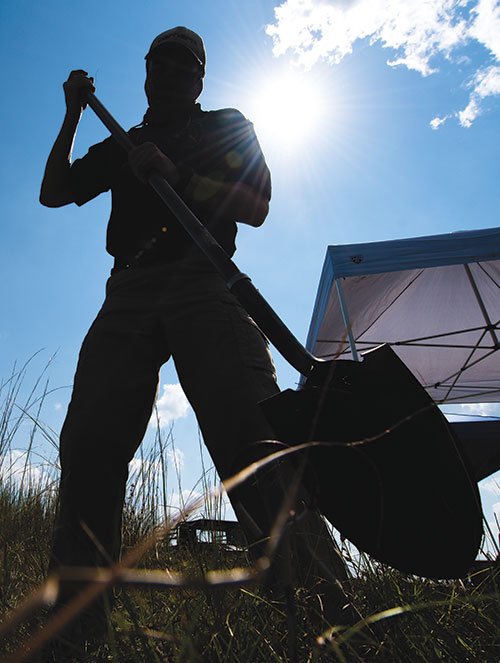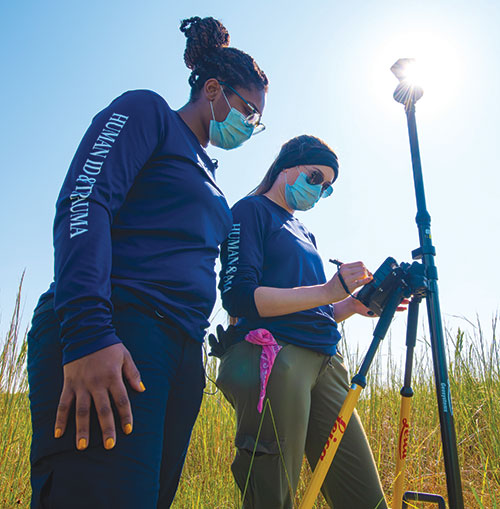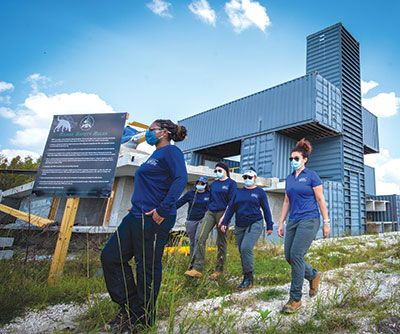LAND O’ LAKES, Fla. – There are certain memories we can’t forget. They’re triggered by random things – a smell takes you back to your grandmother’s house on Christmas morning or the way the clouds darken the sky on a random afternoon transports you back to the day your mother died. Sometimes we collectively remember where we were at a certain moment – like the day John F. Kennedy was assassinated, the space shuttle Challenger exploded, or terrorists attacked the World Trade Center.

The last is true on multiple counts for FGCU Associate Professor Heather Walsh-Haney. She remembers the moment she found out about the 9/11 attacks, but she also knows the smell, sound and sights from being on the ground in New York City during those awful days. As a member of the U.S. Department of Health and Human Services Disaster Mortuary Response Team, Walsh-Haney was called to the Fresh Kills landfill (where evidence was taken from Ground Zero) within three days of the planes destroying the Twin Towers. It’s an experience she will never forget.
While many professors use a memory to offer an anecdote or give students a way to relate to material, Walsh-Haney did something more substantive.
In 2017, FGCU partnered with Florida’s Forensics Institute for Research, Security & Tactics, or FIRST. Managed by the Pasco County Sheriff’s Office, FIRST is dedicated to creating safer communities by enhancing public safety through research, education and innovation. FIRST approached FGCU after hearing about Walsh-Haney’s extensive background in forensic science and significant work with law enforcement to help locate and uncover the dead.
Walsh-Haney shared her experiences from New York and elsewhere to help FIRST create The Urban Search and Rescue Rubble Piles. They are designed to give K9 units and others – like FGCU forensic studies students – a space to train in real-world scenarios.
One pile simulates a bridge collapse. A school bus and several cars look as if they were tossed onto the mounds of smashed concrete. The second pile is considered more treacherous at four stories tall. It was designed to mimic a collapse of an elevator shaft. A full-size helicopter sits on the pile minus its main and tail rotor blades. Students in FGCU’s engineering program helped to design and build both of these training facilities.
“When students choose to become part of our forensic studies program at FGCU, they are committing to finding and studying human remains,” said WalshHaney, an American Board of Forensic Anthropology diplomate, considered a top recognition in the field.
“FIRST helps them understand the physicality of the job. What we do is often uncomfortable for long periods of time. Not to mention, it’s hot, especially in Florida. FIRST – and everything that comes with it – helps my students understand what it takes for them to do this job, remaining a vital, functioning member of a team despite the challenges,” Walsh-Haney said.

The demands of a job in forensic studies are not lost on the dedicated students who make their way to FIRST on a sweltering fall day. Three FGCU graduate students and their professors climb aboard a Pasco County sheriff’s Humvee as they head to a fenced-off tract of field and forest.
The team sets up tents in the rain-softened ground to serve as shields from the relentless sun. They unload shovels and ground penetrating radar that will help them tell the story of what lies in the soil below.

Laboratory coordinator for the FGCU Department of Justice Studies, Dayanira Lopez, pushes the radar equipment across the ground. It resembles a large lawn mower, but is connected to a tablet that can read what might be buried in the ground beneath it.
“These are the three antennas,” she explains. “They can go down as deep as seven meters. All we do is hit play, we will then walk and pause it if we see something. The data on screen will give us measurements and let us know how far we need to dig.”
The team is probing the ground some 200 yards from the rubble piles. To untrained eyes, it may look like nondescript fields and forest but it’s actually another aspect of a unique lab and training ground for students hoping to one day uncover answers for people who no longer have a voice.
Commonly known as a “body farm” – a research facility where decomposition can be studied in a variety of settings – the phrase was made famous by crime novelist Patricia Cornwell in her 1994 book “The Body Farm.”
Walsh-Haney, who chairs the justice studies department, prefers the term outdoor forensics laboratory.
“At FGCU we focus on making sure our scientists are educators and we find ways to take difficult information and present it in a way that students can hold onto,” she said. “Having the opportunity to work outdoors and talk with law enforcement officials and medical examiners about real-world cases helps the students learn on a deeper level.”
Rodgerick Green is the FIRST manager. “This facility will allow practitioners to hone their skills, be better at what they do and pass that on to the students,” Green said.
The outdoor forensics laboratory is the only one of its kind in Florida. Scientists are able to study the decomposition of bodies in a subtropical climate. Students work with state-of-the-art equipment to learn how to locate, excavate and recover surface scattered and buried remains and other types of physical evidence with the help of human detector dogs.
“With the subtropical climate it is brutally hot,” Walsh-Haney said. “We have insects, snakes and other types of animals out here that sometimes pose a threat, and this creates a safe space for the students to work.”
Using ground-penetrating radar and other tools, the students cover the ground slowly and with purpose as they search for body parts.
The ground below is clear, as it should be. At the moment, the facility does not have any bodies in it. Donations have slowed because of COVID-19. But when bodies are donated, the remains are buried or left above ground to be exposed to elements like sun and rain. This is done to mimic the various scenarios officials could come across when working on investigations or natural disasters that involve fatalities.

“When you are in the classroom, you learn it from people who are professionals in the field, but it’s very different when you get to see it in action,” said Lopez. “It’s a completely different feeling, and you know what you’re getting yourself involved in. You can really figure out if this is what you want to do or if there is a different path for you within the field of forensics.”
Graduate student Sonya Concepcion Jones carefully takes measurements and marks a path for the radar with red and yellow flags. She talks through the process with members of the FIRST team. This hands-on and collaborative experience is why Concepcion Jones moved south for the FGCU program.
Her itch for the industry came from watching television shows like “CSI” and “Bones” while in middle school. Her motivation now comes from the families she is helping with the answers she finds.
“The program brought me all the way from New York City because we are getting experience most people will not get until after they graduate and are working,” Concepcion Jones said. “Knowing that I am helping give people answers that don’t have a voice for themselves, that really does hit home for me and has inspired me to stick with this career from the beginning.”
When hearing about the Pasco County facility and the unique work done there, people often ask Walsh-Haney how they can help. She recommends they consider FGCU’s private human remains donation program. She says a lot of donations have come from the families whose loved ones have been the focus of her forensic analyses. The families want to ensure her students train with real human remains and understand the benefits.
“I think of one family who has donated a grandmother and a great uncle,” Walsh-Haney said. “They reach out to me asking to come visit, wanting to see their grandma and learn ‘what your students have found.’”
That granddaughter and great niece is Tanya Scotece. Not only is Scotece’s connection to FGCU her family’s donation, she earned a master’s degree at FGCU in 2009 as one of
Walsh-Haney’s students. With an extensive background in funeral services, Scotece went on to earn a doctoral degree and now teaches at Miami-Dade College.
“There are so many people that don’t know about body or anatomical donation, so I made it my mission to tell them,” Scotece said. “So many people don’t want cremation or to be buried, but they don’t know about this program.”
The skeleton of Scotece’s grandmother and great uncle will not go to the outdoor forensic laboratory, but the bones are helping students further research on campus. The team was even able to pinpoint and diagnose the terrible arthritis in her grandmother’s shoulder she had complained about for years. The family found comfort in learning even more about their loved ones after death.
“I love it because in her day my grandma was always so busy. She was never the type to just sit home and knit,” Scotece said, “so she’s busy even in death.”
Scotece, her mother and her daughter plan to donate their remains to the program. “We all want to go there. I love educating the students. I love giving back,” she said. “I went through Dr. Heather’s program, I learned under her and I saw her work first-hand.”
Walsh-Haney’s work continues to inspire her students, past and present. She’s not only helping them learn the science that is used to solve a crime, but also guiding students through feelings they may be experiencing in what can be an emotionally draining profession. Conception Jones is grateful for WalshHaney’s leadership in a field historically dominated by men.
![]() “It’s so important that women are leading careers and being innovators,” Conception Jones said. “To have mostly women in our program and to be led by Dr. Walsh-Haney, it means a lot to me as a woman, and a woman of color. I am surrounded by supportive and likeminded individuals with similar goals.”
“It’s so important that women are leading careers and being innovators,” Conception Jones said. “To have mostly women in our program and to be led by Dr. Walsh-Haney, it means a lot to me as a woman, and a woman of color. I am surrounded by supportive and likeminded individuals with similar goals.”